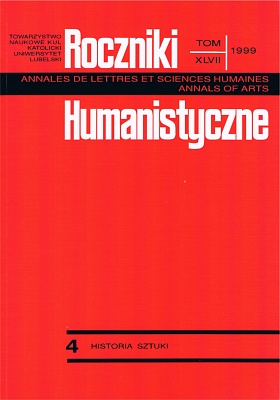The Portrait Gallery in the Palace of the Kraków Bishops in Kielce
Abstract
The portrait gallery in the bishop's palace in Kielce contains thirty-five portraits of the Kraków bishops painted al fresco on the frieze under the ceiling in the Dining Hall on the first elegant floor. Their performers should be found in the workshop of Tomasz Dolabella, as it is indicated by the iconographic inspirations and formal elements. The time when the portraits where painted is dated between 1637, when the construction of the palace was started, and 1645 when the first inventory which included the existence of the gallery in the dining hall was made. The portraits have been repainted and conserved many times, which caused considerable losses in the original painting layer and the original decorative framings have been destroyed.
The Kielce portraits are not innovative as regards their technique and form. They ideally fit into the trend of Sarmatian portrait painting with its characteristic features. The whole of the gallery does not go beyond the common portrait mass production of the seventeenth century. It can easily be classified as one of the series of portrait galleries of clerical dignitaries placed in their palaces as early as from the fifteenth century onwards. Similarly, there were foundations e.g. in Wrocław, Poznań, Wolborz and Łowicz, but none of them exist now. The gallery placed in tradition remains with it in total harmony. Both the theme and its manner of being blended into the space of the dining hall are typical. The only innovative element is the use of the so-called majestic portrait, the iconographic pattern which is rarely found in the first half of the seventeenth century. It is of unique character in reference to the whole series of the gallery portraits.
The Kielce gallery is the oldest modern gallery of the bishop's portraits placed in their seat and preserved in situ. Through its typical character we can imagine other decorations of that type, either destroyed or dispersed. Its significance for our knowledge deals also with the iconography of representations enriched by the unknown forms of the portraits of the Kraków bishops.
It was Bp Jakub Zadzik, afounder of the gallery, who decidedly influenced its form. He fell out with King Vladislav IV and was removed from the post of chancellor. Then he made his own seat a manifestation against King in the struggle for influence and importance. The bishop's portraits fit into the whole of the ideological programme of the Kielce residence. They belong to that type of representations of the “predecessors at the post” whose idea was to show the continuity and ancient character of the power, manifesting thereby its dignity and legitimization, that legitimatio potestatis, in the eyes of the society. The Kielce gallery has been formed in accordance with the requirements of the epoch of the Counter-Reformation, and expresses the same idea of legitimizing the reign, which we find in the medieval series of the hieratic portraits of bishops. The proud series of the predecessors at the chair affected, in the spectator's reception, the perception of man who presently ruled their legacy. The founder tended to take advantage of all the trump cards that his status gave him for propaganda purposes, ordering portraits for the elegant hall of the Kielce palace.
Copyright (c) 1999 Roczniki Humanistyczne

This work is licensed under a Creative Commons Attribution-NonCommercial-NoDerivatives 4.0 International License.





